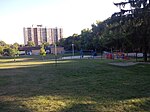Danforth Collegiate and Technical Institute

Danforth Collegiate and Technical Institute (known as Danforth CTI, DCTI, or Danforth), formerly Danforth Technical School and Riverdale Branch Technical School is a secondary school in east Toronto, situated to the east of the city's Greek neighbourhood and between the Greenwood and Donlands subway stations. As the name suggests, it is set up as a technical school, with trades training and special shops for auto repair, carpentry etc. Danforth was built as a specialist technical school in 1922, so it has a number of specialist areas and a fair stock of equipment. It is a part of the Toronto District School Board (TDSB). Prior to 1998 it was within the Toronto Board of Education (TBE). Attached to Danforth is the Toronto Urban Studies Centre, an outdoor educational school. The school's motto is "Faciendo Discimus," which means "We learn by doing."
Excerpt from the Wikipedia article Danforth Collegiate and Technical Institute (License: CC BY-SA 3.0, Authors, Images).Danforth Collegiate and Technical Institute
Greenwood Avenue, Toronto
Geographical coordinates (GPS) Address Phone number Website External links Nearby Places Show on map
Geographical coordinates (GPS)
| Latitude | Longitude |
|---|---|
| N 43.682759 ° | E -79.334274 ° |
Address
Danforth Collegiate and Technical Institute (DCTI)
Greenwood Avenue 800
M4J 4B7 Toronto
Ontario, Canada
Open on Google Maps









